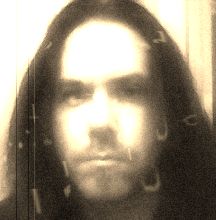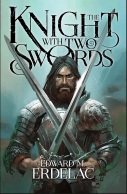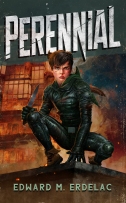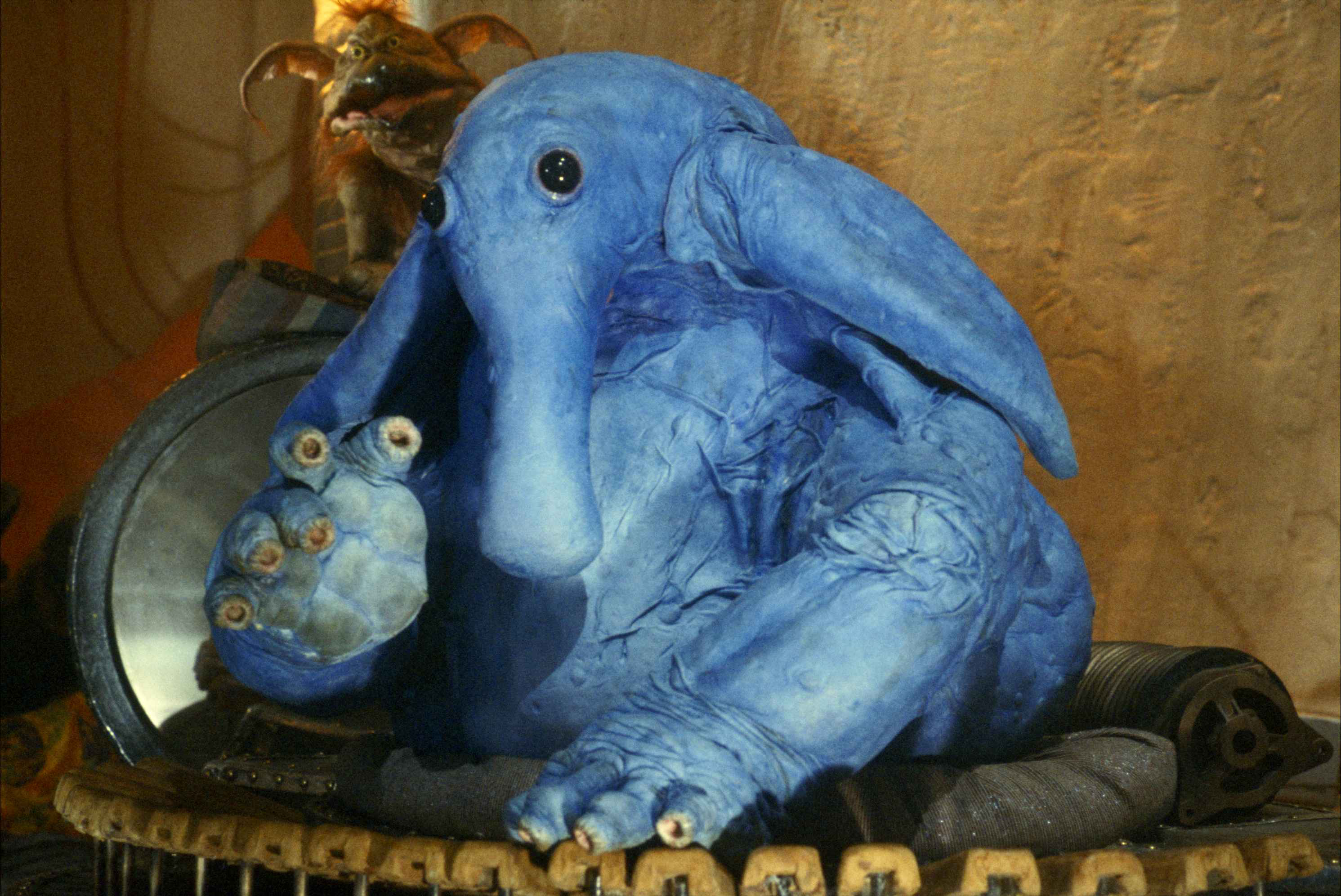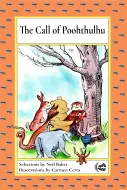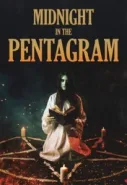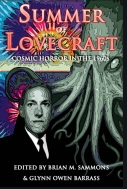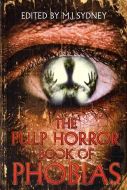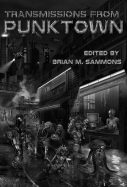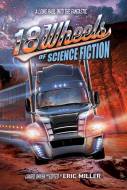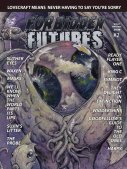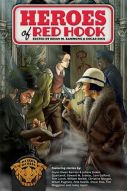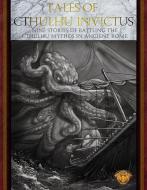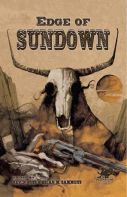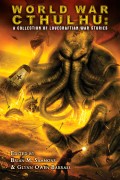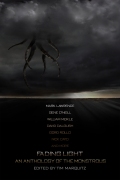The Merkabah Rider series from Damnation Books follows the weird western adventures of a Hasidic gunslinger tracking the renegade teacher who betrayed his mystic Jewish order of astral travelers across the demon haunted Southwest of the 1880’s. Along the way the Rider (so called because he has hidden his true name to protect himself from his enemies) confronts half-demon outlaws, animated windmills,possessed gunmen, cultists, a bordello of antedeluvian succubi, Lovecraftian entities and various other dangers.
To evoke the old Zebra/Lancer/Bantam paperback collections of Robert E. Howard’s Solomon Kane and Conan, the novels are presented as collections of standalone but sequential novellas. The series currently consists of two installments, Tales of a High Planes Drifter and The Mensch With No Name, both available in print and ebook formats on Amazon.com.
This year will see the release of Have Glyphs Will Travel, the third book in the series. Included are five novellas, detailing the Rider’s dealings with extra-dimensional angels, zombies, turncoat Riders, the wrath of the Demon Queen Lilith, Navajo skinwalkers and Native American shapeshifters, fire demons, a future instructor at a certain infamous Massachussetts institution of higher learning, and his greatest enemy.
Here’s an exclusive taste of what’s to come.
In this excerpt from one of the five novellas, The War Prophet, the powerful Native American mystic (and the Rider’s old acquaintance) Misquamacus has gathered an army of vengeful warriors from various castout tribes in an effort to unify them against the white man’s encroachment and depradations, all under the power of his dark magic.
Seeking to add the might of the Chiricahua Apache nation to his own, he has called their greatest leaders to a secret meeting high in the Sierra Madres, where he has made them a tempting offer. Turn away from their traditional religion and embrace the dark gods of Misquamacus and the white nation will be rubbed out….
*
Many of the frightened rurales were cursing, wide-eyed, shaking their heads. Many more were praying. Some were even kissing crosses that dangled from wooden bead rosaries around their necks, tucked into their dirty shirts so that the Lord did not see the terrible things they did, but so that He could be gotten to in a pinch if needed.
One Mexican among them, an old vaquero on his knees, was laughing. The Rider saw Mendez, the corporal. He stood bewildered, hands snatching at the empty holsters on his belt.
“They are for you, my brothers!” Misquamacus hollered above the din of the jabbering Mexicans, his voice powerful, resounding off the great rock walls. “Do with them what you want to do!”
And they did.
Almost as one body the Indians fell hungrily upon the cringing Mexicans like a great mouth closing. Some gamely fought back, but they were unarmed and outnumbered and quickly dragged down. Not a single bullet was wasted. Those with rifles came at the rurales with the heavy butts of their weapons, dashing skulls open at a swing. Stone axes whistled and sunk into pleading faces, and were drawn out to scatter brains and teeth and then fall again. Knives flashed, passing through scalps pulled so tight they came free in the bronze fists that held them with a single swipe and left glaring patches bereft of hair and flesh, the faces of their howling victims swiftly vanishing in a curtain of blood. Machetes swept off hands and fingers interlaced in desperate prayer.
Big Anger and his Pawnees straddled their victims and worked vicious arts with their knives, slashing away age, race, and sex, leaving behind only meat, indiscernible from a butcher’s wares. Organs leapt into the air like hats on New Year’s Eve.
The Rider/Piishi saw Slim Ghost and the skinwalkers walking among the dead and dying with curved knives, stooping to extract eyes, hearts, livers, fingers, genitals, even twisting free bloody bones, all of which they stuffed into their hide satchels, for later use in their foul practices, no doubt.
The Ishaks and the Tonkawas fell wholly upon their kills, burying their faces in the cavernous wounds they ripped open with their fingers.  Piishi’s digestive system reacted with violent disgust at their display, and the Rider put the back of his hand to his lips and swallowed rising bile as Moon Cloud and Bloody Jaw wrestled over the bloody corpse of a fat rurale. One end of a rope of intestines twisted in-between each man’s teeth, the two of them snarling at each other like wild dogs. Indeed, they looked very much like animals. Their eyes grew wide and black , and they seemed hairier than before. Their ears elongated, sharpening in elfish grotesqueness, and their teeth were suddenly pointed and jagged, wolf-like in their gory mouths, extending in some kind of perverse, ravenous arousal. They were changing before their very eyes, something in their doing bringing out their true, inhuman natures, until Bloody Jaw was more wolf than the black hide and cowl trappings that hung from his bulky, misshapen shoulders. Moon Cloud matched his bestial visage.
Piishi’s digestive system reacted with violent disgust at their display, and the Rider put the back of his hand to his lips and swallowed rising bile as Moon Cloud and Bloody Jaw wrestled over the bloody corpse of a fat rurale. One end of a rope of intestines twisted in-between each man’s teeth, the two of them snarling at each other like wild dogs. Indeed, they looked very much like animals. Their eyes grew wide and black , and they seemed hairier than before. Their ears elongated, sharpening in elfish grotesqueness, and their teeth were suddenly pointed and jagged, wolf-like in their gory mouths, extending in some kind of perverse, ravenous arousal. They were changing before their very eyes, something in their doing bringing out their true, inhuman natures, until Bloody Jaw was more wolf than the black hide and cowl trappings that hung from his bulky, misshapen shoulders. Moon Cloud matched his bestial visage.
The Rider looked through the massacre and found Goyaałé. The Bedonkohe war chief had made his way to the still laughing old caballero, and hoisted him to his feet. He raised his bloody knife to end him.
“Goyaałé!” The Rider called in as loud a voice as he could manage, which was considerable, given the acoustics of the canyon.
Goyaałé heard, and paused to look. A moment’s searching and he found the source.
“Look!” The Rider yelled, pointing to Moon Cloud and Bloody Jaw.
Goyaałé followed the indicatory gesture and his lip curled when he saw the two transformed chiefs. He let the old caballero fall and backed away. His eyes flitted all around the killing ground, and he saw the other Ishaks and Tonkawas changing into wolf-beasts.
The Rider watched as Goyaałé rushed through the crowd and found Lozen and Vittorio. He snatched the rifle from Lozen’s belt.
Before she could react, he levered it and fired it into the air.
It was a startling sound, and every man and woman stopped. Even the hairy beasts that had once been Indians raised their elongated doggish muzzles from the bellies of their kills and regarded him with feral eyes.
Lozen moved to take the rifle back, but Goyaałé said something and pointed.
All the Apache, their attention momentarily lifted from their bloody work to the two leaders, followed their shocked gazes and saw.
And as one, just as they had closed upon the Mexicans, they now recoiled and withdrew. Not a single Mexican was still alive.
“What is this, Mis-kwa-macus?” Vittorio yelled, pointing to the wolf creatures. “What are these?”
“They are the Rugarou Ishaks and the True Tonkawas. The last of their kind,” said Misquamacus. “Just as I told you.”
“They are monsters!”
The blood spattered Apache voiced their agreement with angry and frightened shouts.
“Not so! Not so!” Misquamacus yelled over them. “They are your brothers, ready to fight the white man at your side. Does Usen not teach you that the beasts are your kin? Do you not emulate the ferocity of the puma and the cunning of the beaver?”
One of the skinwalkers was nearby, and Goyaałé rushed at him without warning and cut his satchel from his shoulder with his knife, then shook out its grisly contents on the ground, where all could see them. The shriveled fist of a child rolled out among the fresh trophies.
“Usen does not teach us this!” he called.
“You have said that we must turn from Usen to defeat the white man,” Vittorio said. He pointed to the transformed Ishaks and Tonkawas. “Is this what happened to them when they turned from their god?”
 “I offer you the death of the white man and the Mexicans for all time,” said Misquamacus. “I offer you a thousand nights like this one, with your enemies beneath your knives. With the power of my god, I can snatch the Great Father in Washington from his house and bring him to us. I can pull the rails out from under the iron snakes and fling them into the air. I can put my hand over the soldier forts that rise like ugly boils across all the land and send you in to cut their throats in their beds. I can turn the weapons of the enemy against them, make their ponies burst into flame between their legs, turn their bullets to raindrops. I can geld the white man and seal up his women. I can make it so your children will never know those people but from the stories told around your fires.”
“I offer you the death of the white man and the Mexicans for all time,” said Misquamacus. “I offer you a thousand nights like this one, with your enemies beneath your knives. With the power of my god, I can snatch the Great Father in Washington from his house and bring him to us. I can pull the rails out from under the iron snakes and fling them into the air. I can put my hand over the soldier forts that rise like ugly boils across all the land and send you in to cut their throats in their beds. I can turn the weapons of the enemy against them, make their ponies burst into flame between their legs, turn their bullets to raindrops. I can geld the white man and seal up his women. I can make it so your children will never know those people but from the stories told around your fires.”
“Who is your god that promises us these great victories, Mis-kwa-macus?” Goyaałé demanded. “It is time you told us.”
“Yes,” said Vittorio. “Who is your god that is so great but would bother with us?”
In answer, Misquamacus raised his arms for silence.
Slim Ghost and eight of the skinwalkers went to the base of the stone and knelt in a circle. They upended a series of small black pouches from their satchels into their hands and closed them into fists. Colored sand ran through their fingers, and with measured care they began to let the sand fall in ordered patterns on the bloody red earth. It was wondrous to see them work, ten men making a large vaguely circular picture, each acting independently, and yet their labors taking on a unified pattern, as if they possessed one mind, one vision. Silently, and without pause or consultation, they worked, forming mystic shapes and figures incomprehensible to outsiders and yet obviously inspired. As they worked, the colored sand drank up the spilled blood beneath, darkening in color where it fell.
The others watched them restlessly. The sun sank, and campfires had to be lit. All this was done in silence. No one dared to interrupt the skinwalkers’ work.
When it was at last finished, they rose as one and returned to the ranks of their people, and a mesmerizing sand painting lay before the stone on which Misquamacus had stood the whole time, observing. Red and blacks and blues dominated the work, and there were dancing feathered figures, moons, stars, and geometric patterns. To the Rider, only a few of these seemed somewhat familiar, some of them not unlike the diagrams found in the Book of Zylac. Yet all were distinctly Indian in their interpretation. Central to the painting was a strange faceless humanoid shape of black sand.
Misquamacus removed something from his satchel then, a polished mirror fragment, the size of a man’s head. He placed it in the center to the sand painting, over the center shape.
Then, before their eyes, that black shape began to grow oily and to boil like hot tar.
A lump rose from the center and took shape, congealing into a man-like form, carrying the fragment of mirror with it. Steam rose from the thing, as if it was hotter than the cool mountain air around it. When it had completed its unnatural birth, it stood nearly eight feet tall, like an earthen statue, black, with bumpy skin, like a flayed corpse, faceless but for the smooth mirror.
The Rider/Piishi recognized the same being they had seen in Misquamacus’ wickiup.
The Dark Man.
Black, foul smelling smoke, like the oily stench of a machine fueled by corpses, pouring from around the edges of the thing’s mirror mask, billowing unnaturally around the figure, never rising, cloaking it in a greasy fog.
The Ishaks and Tonkawas fell to all fours and pressed their jaws to the earth like submitting hounds. They sent up a bone chilling baying and howling din, so terrible that the Apaches clamped their hands over their ears to hear it. The Pawnees put their foreheads to the earth, and even the skinwalkers knelt and bowed their heads. The Apaches moved away, frightened of the thing.
Misquamacus turned and went to his knees, arms still above his head in adoration.
“Behold Tezcatlipoca! The Dark Wind. We are his slaves. Nyarlathotep!”
Merkabah Rider 3: Have Glyphs Will Travel
Pick up the book here –







